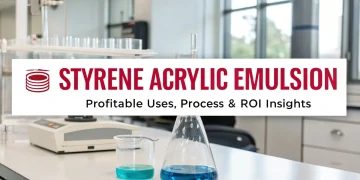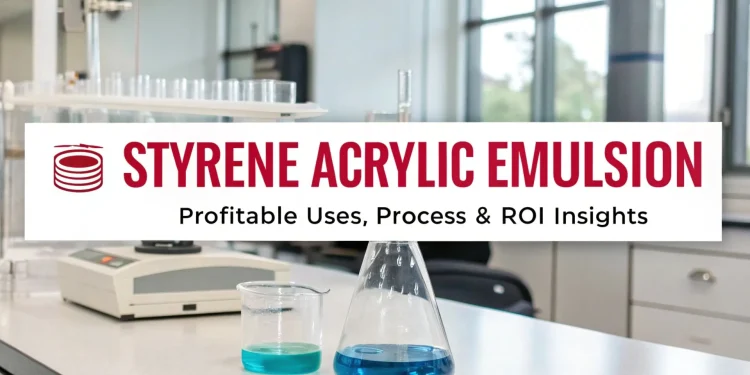Styrene Acrylic Emulsion copolymers are an important class of emulsion polymers due to their unique properties. They are a middle ground between pure acrylic and styrene systems, providing a good balance in cost, performance, and versatility. The last few decades have seen considerable evolution in styrene-acrylic emulsion polymerization owing to improvements in surfactant technology, environmental policies, process efficiency, and the need for high-performance water-based products.
Styrene-acrylic emulsion polymers find applications in architectural paints and construction adhesives, as well as in textile coatings and finishes for paper. The innovation potential in this area is especially important with the global market shifting to sustainable solutions and a focus on VOC-free products.
NIIR Project Consultancy Services (NPCS) as an example has been actively assisting chemical manufacturers and entrepreneurs, along with R&D labs, providing tailored reports and chemical feasibility reports for styrene-acrylic emulsion polymer projects. These comprehensive reports serves as an assurance for new ventures into the specialty polymer market with robust foresight.
Market Overview and Its Strategic Importance
It is anticipated that by 2030, the global Styrene Acrylic Emulsion polymer market will exceed 60 billion USD, with a significant proportion stemming from styrene acrylic emulsions. One of the primary drivers is the growing preference of low-VOC, water-based, and eco-friendly paints and polymers used in decorative painting, paper coating, and even packaging industries. In India, the domestic consumption of styrene-acrylic emulsions is being spurred by the enhanced growth of construction, packaging, and automotive industries along with the “Make in India” and “Green Chemistry” policies by the government.
These types of emulsions are more economical than 100% acrylic emulsions because of their weather resistance, gloss retention, alkali resistance, and enhanced binding of pigments. They are also used extensively in flexible adhesives, pressure-sensitive labels and high gloss coatings, cementitious mortars, and waterproofing membranes.
Entrepreneurs can take advantage of the opportunity to locally produce styrene-acrylic emulsions due to the increase in preference for aqueous polymer dispersions as opposed to solvent-based systems. NIIR Project Consultancy Services gives comprehensive assistance through feasibility reports and tailored suggestions such as costing, sourcing of materials, and possible environmental compliance pathways on the project.
Related: How to Start an Acrylic Polymers Manufacturing Business?
Basics of Styrene Acrylic Emulsion Polymerization
Styrene Acrylic Emulsion polymerization is a heterogeneous process that includes the combination of monomer droplets, water, surfactants, and initiators to achieve stable polymer emulsions. For the case of styrene-acrylic copolymers, acrylics such as butyl acrylate, methyl methacrylate, or ethyl acrylate provide flexibility, adhesion, and UV resistance while styrene serves as a hard monomer to improve film forming and mechanical strength.
The polymerization process consists of several stages. It starts with the formation of pre emulsion of monomers, followed by polymerization initiation with water-soluble initiators like ammonium or potassium persulfate, and growth through micelle and particle nucleation. The ratio of monomers used selects the glass transition temperature (Tg) and application characteristics.
Contemporary methods for styrene acrylic emulsion manufacture use batch or semi-continuous processing combining inline control of pH, temperature, surfactant addition, and high solids content (45–55%), narrow particle size distribution, and low residual monomer levels. In polymerization, steps following monomer addition include stripping unreacted monomers, stabilizing with protective colloids or surfactants, and filtrating to remove coagulum.
Formulators may add acrylonitrile, methacrylic acid, or hydroxyl-terminated monomers that change surface energy or crosslinking to change the chemical resistance of the emulsion. Thus, tailored emulsions are designed for industrial coatings, sealants, and textiles.
Machine and Plant Arrangement for Production of Styrene-Acrylic Emulsion
Production of styrene acrylic emulsions requires drone-controlled equipment for polymer precision, batch repeatability, and operator safety. Such a manufacturing facility will have core process units including jacketed stainless steel reactors, high-speed emulsifiers, monomer dosing pumps, vacuum stripping units, inline homogenizers, and others.
This process starts with the stir tank wherein surfactants, monomers, and water are combined to build a stable emulsion which is transferred to the reactor under an inert gas blanket. The addition of a nitrogen purging system will further facilitate the decrease of oxygen inhibition. Thermodynamic initiators can be added either batch-wise or through metered dosing and real-time temperature, and pressure monitoring guarantees optimal conversion alongside polymer precision.
Post polymerization, the emulsion undergoes vacuum stripping and downstream rightsizing to remove any residual volatile impurities. Following this, cooling and neutralization phases are conducted before the emulsion is transferred to 316L steel vessels after filtration to remove coagulated particulates.
SCADA systems, viscometers, monomer handling safety units and PLC systems for process automation can further enhance the precision dose features. The plant design will also require space for raw material receipt, QC laboratories, fire-fighting units, and systems for effluent recirculation and treatment.
NIIR Project Consultancy Services helps clients with ensuring optimal and seamless plant setup through detailed engineering designs, equipment lists, layout drawings, and identification of relevant vendors.
Raw Materials and Supply Chain Considerations
Core Styrene Acrylic Emulsion Polymerization raw materials include:
- Monomers: Styrene, Butyl Acrylate, Methyl Methacrylate, Ethyl Acrylate
- Initiators: Potassium persulfate, Ammonium persulfate, Redox initiators
- Surfactants: Anionic and nonionic emulsifiers, SDS, APE-free surfactants
- Buffering agents: Sodium bicarbonate or phosphate salts
- pH Regulators and Neutralizers: Ammonia, TEA, or sodium hydroxide
- (Optional) chain transfer agents: Ammonia, TEA, or sodium hydroxide to control molecular weight
- Water: For consistent polymerization, deionized or filtered water is critical
Ensuring a consistent supply of surfactants and monomers is essential for consistent production. India does have a well-established petrochemical industry, supporting local production. However, entrepreneurs need to keep an eye on global crude oil prices affecting styrene price volatility.
NIIR Project Consultancy Services supports clients in critical chemical import substitution to reduce dependency on imports, advising on chemicals’ vendor selection, their compatibility with materials, handling procedures, and inter-company chemical transport protocols.
Plant Infrastructure and Utility Requirements
Land on a zoned chemical or industrial estate is preferred for a mid-scale plant operating at 2,000 to 3,000 tons per annum as it will need 1 to 1.5 acres of land. The plant infrastructure consists of monomer and surfactant storage, reactors, emulsification units, QC labs, finished products storage, and utility areas like boilers, chillers, compressors, and wastewater treatment plants.
A hot water supply and cooling towers for controlling exothermic reactions are required for crescent steam boilers ranging from 1–2 tons/hour. Electricity needs to be dependable during the process, and for the automation of energy-intensive areas requiring 150–300 kVA, water supply reliability is essential.
Disposal of polymer surges and rinse water containing surfactants and organics is prohibited without treatment; therefore, destroying polymer slurry, neutralization combined with coagulation-flocculation, and activated sludge are required.
Related: Acrylic Acid Production from Propylene
Environmental, Health, and Safety Issues
Styrene and acrylate monomers must be handled while taking into consideration workplace safety and environmental guidelines. Monomers are classified as Volatile Organic Compounds (VOCs) which require PPEs, well-ventilated rooms, and flameproof fittings, along with vapor recovery systems and leak detectors.
Effluent and emissions are bound to CPCB and SPCB norms, whereas solid waste (polymer sludge) as well rinse waters need special treatment systems. Moreover, the plant operations must also incorporate fire safety controls, spill containment, emergency egress, and active safety inspections.
As with all consultancy projects, NIIR Project Consultancy Services integrates an EHS roadmap into the report where best known methods, compliance steps, and licensing from MoEF, PESO, and Factory Inspectorate are highlighted alongside EHS compliance frameworks.
Innovative Trends in Styrene-Acrylic Emulsions
The innovation in monomer chemistry, polymer architecture and tailored application drive the evolution of styrene-acrylic technology. Traditional emulsifiers are being substituted with APEO-free surfactants. There is also a trend towards high solids (>60%) and low VOC’s formulations.
Other notable trends are:
- Emulsions with self-cleaning and anti-fungal coating functions
- Pigments used for finishes of ultra-high gloss
- Incorporation of silicone or epoxy crosslinkers into hybrid systems
- Green surfactants and bio-based monomers spearheaded
- Smart emulsions triggered by pH, UV, or temperature changes
For the above-mentioned innovations, NIIR Project Consultancy Services tracks these emerging innovations and provides formulation insights along with R&D tie-ups and technology transfer collaborations.
NIIR Project Consultancy Services: Offerings and Support
Let’s talk about other options of the NIIR Project Consultancy Services.
For any and all projects in styrene-acrylic, NIIR offers: Detailed Project Reports tailored to capacity and application. Along with many more such as:
- Project and business opportunities for experts in chemical and polymer
- Market and competition benchmark
- Sourcing document for the machinery including contract award and subcontractor
- International and national regulatory structure including EHS
- Economics of the project along with bank loan documents
Conclusion
The processes involved in styrene–acrylic emulsion polymers are much more than technical in nature—it is an opportunity driven by shifts in the market, technology, regulations, or new innovative products. For new entrants into the specialty chemicals and water-based polymers sectors, investment in the emulsions brings high returns and a strong market need, while also adhering to goals of sustainable development (SDG).
Following the proper technological routes and with the right infrastructure in place, along with the professional backing from NIIR Project Consultancy Services, your concept-to-commissioning journey can be easy, compliant, cost-effective, and profitable. The world is shifting to green formulations, making this the best time to invest in styrene-acrylic emulsions and drive innovations toward a sustainable future.


























